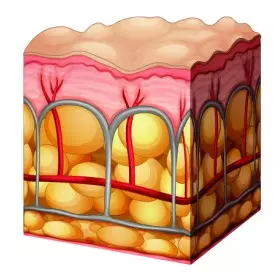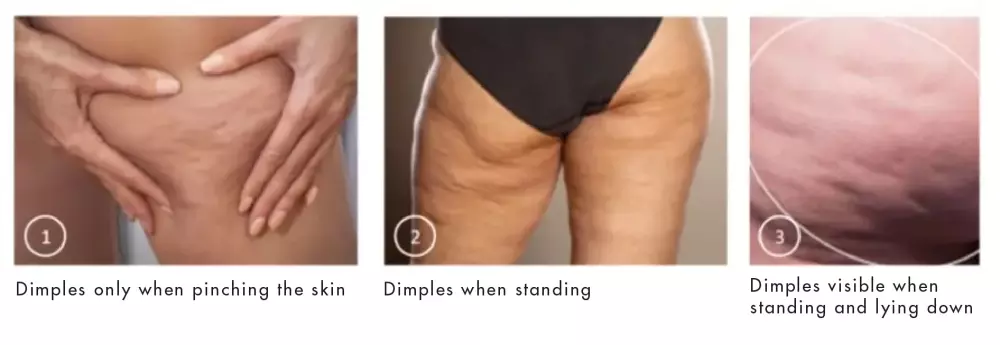LIPOCLINIC St. Gallen
9000 St. Gallen
LIPOCLINIC Zürich
8004 Zürich
Approximately 80-90% of all women over the age of 20 suffer from cellulite at some point in their lives – in other words, almost all of them. The reason why almost exclusively women are affected by cellulite is anatomical in nature: the skin of men vs. women is structured differently; the epidermis of women is thinner, the dermis underneath is more flexible.

Women have more and larger fat cells in the subcutaneous tissue, which are grouped together in fat chambers. These can increase in size up to tenfold and form food reserves during pregnancy. The fine strands of female connective tissue run perpendicular to the surface of the skin and almost parallel to each other, which is why they are very stretchy – small, flexible columns that yield easily to the pressure of the fat chambers. The "bumps" of cellulite are caused by too much or too little volume of fat cells between the connective tissue or the storage of fluid as well as the loss of elasticity of the connective tissue fibers. Fluctuating weight or sport, but especially genetics, UV radiation and hormones play a major role in the formation of cellulite.
In summary, cellulite is mainly caused by a change in the collagen in the subcutaneous tissue, which leads to soft, pliable connective tissue under the skin. An excess (oedematous cellulite, also known as congestive cellulite) or a deficit (flabby cellulite) of volume then leads to unsightly irregularities in the skin. A third cause of cellulite is retraction of the connective tissue, which causes the "deep dimples" (dimpled cellulite).
Congestive cellulite is usually caused by lymphatic congestion in the subcutaneous tissue, which is why it resembles orange peel skin. It is also known as grade 1 cellulite; dimples only appear when the skin is pulled together. With this type of cellulite, good results are usually achieved with exercise, diet and suction roller massage (endermologie®).
Getting rid of sagging cellulite is more difficult. This type of cellulite is caused by soft, lax-looking skin. Here, women often have the feeling that they have "excess skin". The tissue on the body "wobbles" when walking, it feels soft and empty.
Causes of Sagging Cellulite
The cause is a degeneration of the connective tissue scaffolding under the skin. The connective tissue fibers have lost their firmness and can be stretched like rubber, which explains the phenomena you feel. Hormonal changes are the main cause, along with the constitution and age-related degeneration. These factors also lead to a decrease in fluid in the tissue, which explains the feeling that the connective tissue is empty. This appearance is also known as grade 2 cellulite, where the cellulite is already visible when standing.
Dimpled cellulite is the name given to skin that is characterized by large irregular indentations. This gives the feeling that the dimples are pulling the skin downwards. The cause is a further degeneration of the subcutaneous connective tissue fibers, which partially harden and thus shorten.
This type is called grade 3 cellulite; the cellulite is not only visible when standing but also when lying down. This type of cellulite is often accompanied by flabby cellulite.

A low-fat and low-sugar diet is a good start in the fight against cellulite. Exercise and physical activity are also necessary to burn fat and stimulate blood circulation in the body. Exercise builds up muscles, which can alleviate cellulite. Accompanied by e.g., LPG (suction roll massages), the result can be better achieved.
If exercise and dieting do not show any desirable improvement, you can also have your cellulite treated cosmetically. Find out more about our anti-cellulite treatments and how you can get rid of cellulite.
We understand that aesthetic treatment needs to be carefully considered. We are therefore happy to take the time to answer all your questions during a free, no-obligation initial consultation. Arrange your consultation appointment today at one of our two LIPOCLINICs.
If you would like a brief online preliminary clarification before your consultation, you can also contact us by e-mail.
No matter how you want to reach us – we look forward to hearing/reading from you!